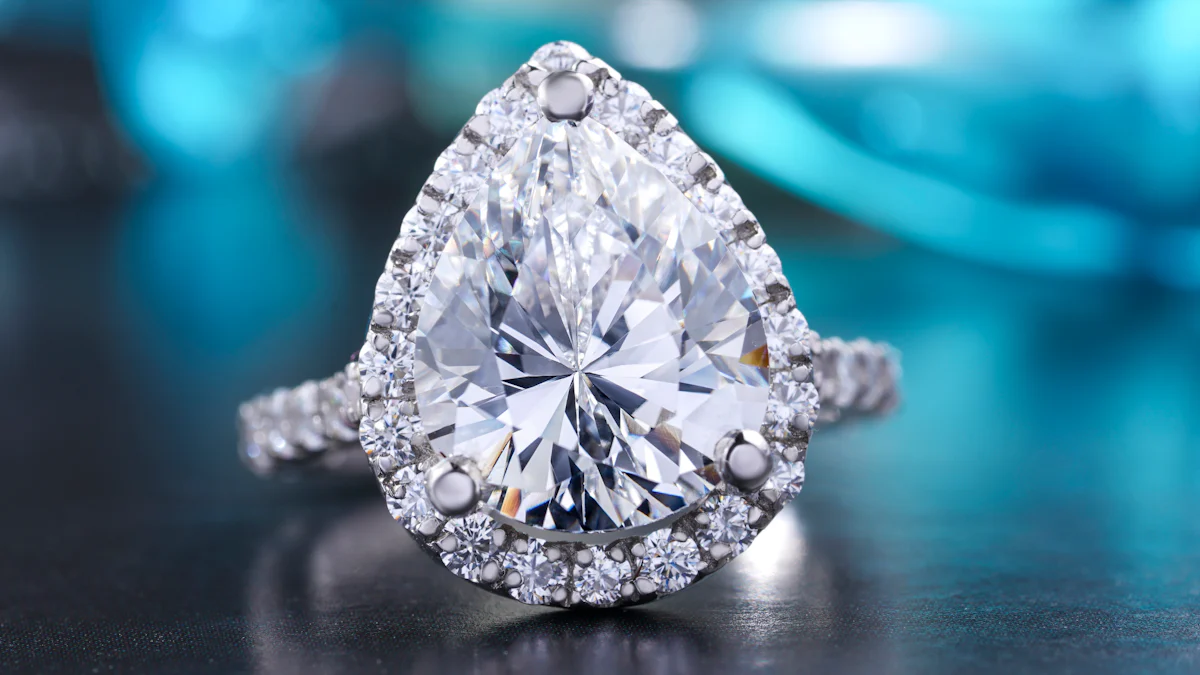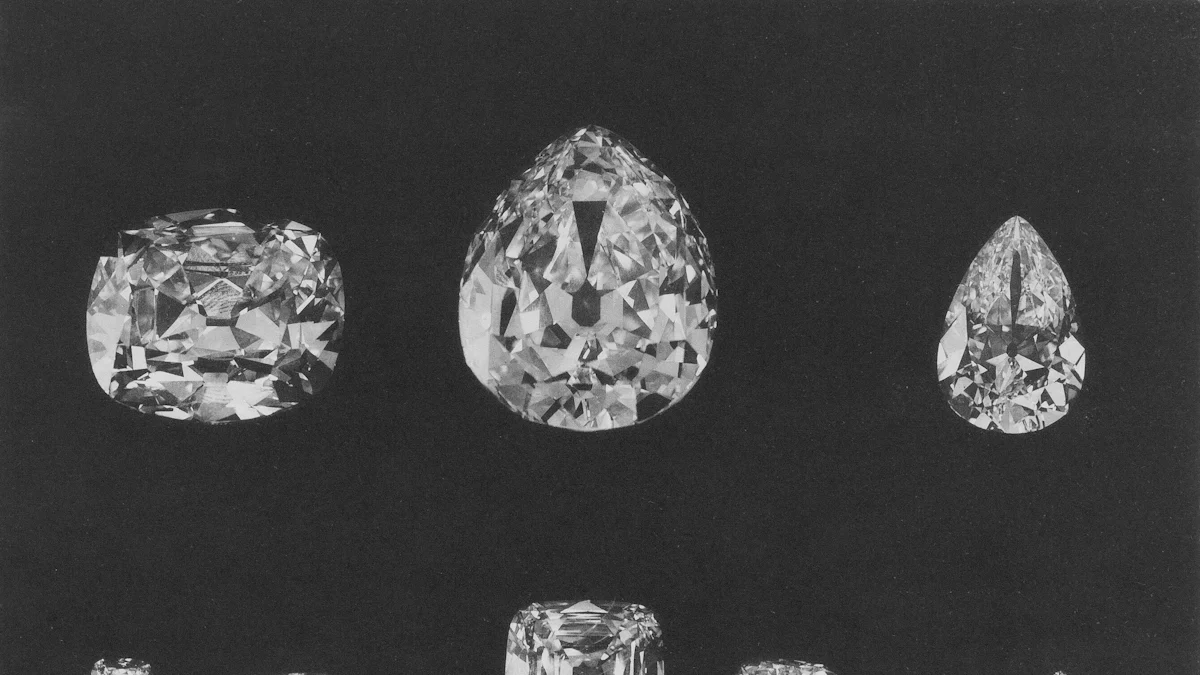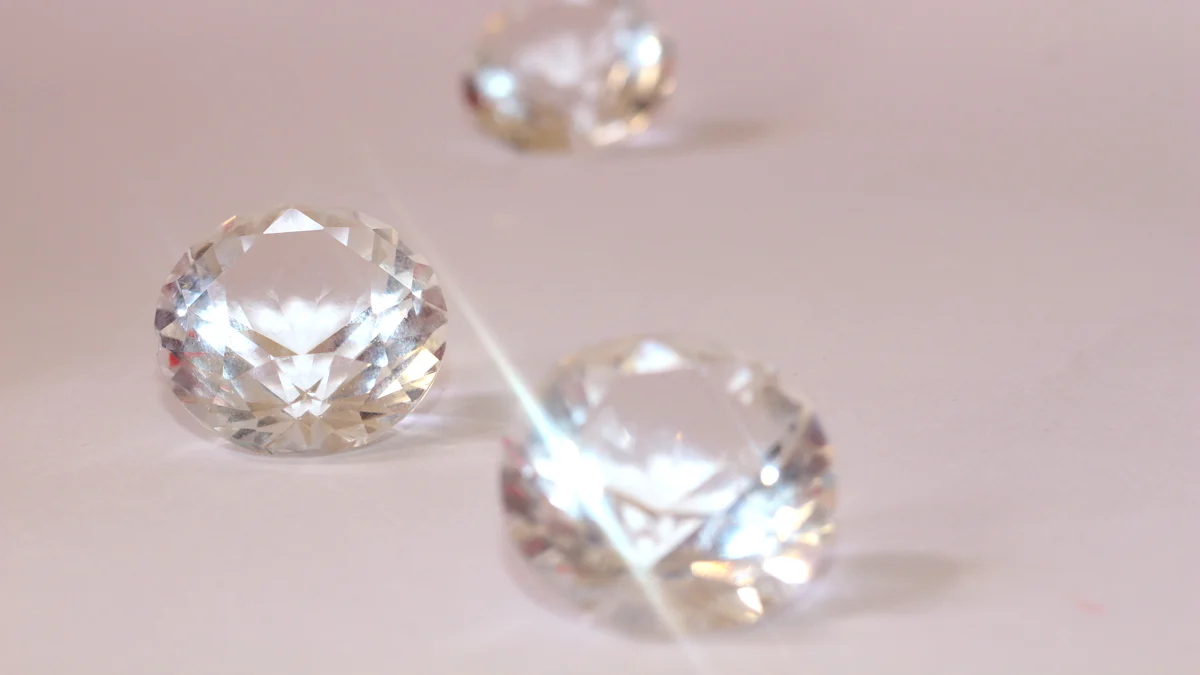What Is the Best Diamond Clarity Explained

When you think about what is the best diamond clarity, Flawless (FL) and Internally Flawless (IF) often come to mind. These diamonds stand out because they have no visible inclusions or blemishes. Imagine owning a diamond that belongs to the rarest category, with less than 0.05% of all diamonds achieving this level of perfection. Such clarity not only enhances the diamond's beauty but also its value. You might wonder if these are the right choices for you, considering their rarity and allure.
Understanding Diamond Clarity
What is Diamond Clarity?
When you look at a diamond, you might wonder what makes it sparkle so beautifully. One key factor is its clarity. Diamond clarity refers to the absence of internal flaws, known as inclusions, and surface defects, called blemishes. These imperfections can affect how light passes through the diamond, impacting its brilliance and overall appearance. The fewer the imperfections, the clearer and more valuable the diamond becomes. So, when you ask, "what is the best diamond clarity?" you're essentially inquiring about the level of perfection in a diamond's structure.
How is Diamond Clarity Graded?
Grading diamond clarity involves a meticulous process that requires expertise and precision. Here's how it works:
The Role of Gemologists
Gemologists play a crucial role in determining a diamond's clarity. They are trained professionals who examine diamonds under specific conditions to assess their quality. Using their keen eye and extensive knowledge, they identify and evaluate the size, number, and position of any inclusions or blemishes. Their judgment is essential in assigning a clarity grade, which helps you understand the diamond's quality.
Tools and Techniques Used in Grading
To accurately grade a diamond's clarity, gemologists use specialized tools and techniques. The most common tool is a 10x magnification loupe or microscope. This allows them to see details not visible to the naked eye. They examine the diamond from multiple angles to ensure a comprehensive assessment. The grading process follows strict criteria, such as those set by the Gemological Institute of America (GIA), ensuring consistency and reliability in clarity evaluations.
Understanding these aspects of diamond clarity helps you make informed decisions when selecting a diamond. Whether you're looking for the best diamond clarity or balancing other factors like cut and color, knowing how clarity is determined can guide you toward the perfect choice.
The Diamond Clarity Scale

Understanding the diamond clarity scale is crucial when you're trying to determine what is the best diamond clarity for your needs. This scale helps you evaluate the quality and value of a diamond based on its internal and external characteristics.
Overview of the Clarity Scale
The clarity scale ranges from Flawless (FL) to Included (I3). Each grade reflects the visibility and impact of inclusions and blemishes on the diamond's appearance. Here's a quick rundown:
- Flawless (FL): No inclusions or blemishes visible under 10x magnification.
- Internally Flawless (IF): No inclusions, only minor blemishes visible under 10x magnification.
- Very Very Slightly Included (VVS1 and VVS2): Minute inclusions that are extremely difficult to see even under 10x magnification.
- Very Slightly Included (VS1 and VS2): Minor inclusions that are somewhat easy to see under 10x magnification but invisible to the naked eye.
- Slightly Included (SI1 and SI2): Noticeable inclusions under 10x magnification, which might be visible to the naked eye.
- Included (I1, I2, and I3): Obvious inclusions that can affect transparency and brilliance.
Detailed Look at Clarity Grades
Flawless (FL) and Internally Flawless (IF)
Flawless and Internally Flawless diamonds represent the pinnacle of clarity. These diamonds have no visible inclusions or blemishes, making them incredibly rare and valuable. If you're seeking perfection, these grades are ideal, though they come with a hefty price tag.
Very Very Slightly Included (VVS1 and VVS2)
VVS diamonds have inclusions so tiny that even skilled gemologists find them challenging to spot under magnification. These diamonds offer a near-perfect appearance without the cost of FL or IF grades, making them a popular choice for those who want high clarity without breaking the bank.
Very Slightly Included (VS1 and VS2)
VS diamonds strike a balance between clarity and value. Their inclusions are minor and typically invisible to the naked eye, providing an excellent option for those who want a beautiful diamond without paying for higher clarity grades.
Slightly Included (SI1 and SI2)
SI diamonds have inclusions that are more noticeable under magnification and sometimes visible to the naked eye. However, they often appear "eye-clean," meaning their inclusions aren't easily seen without magnification. These diamonds offer good value for those prioritizing size or other factors over absolute clarity.
Included (I1, I2, and I3)
Included diamonds have obvious inclusions that can affect their brilliance and transparency. While they are the most affordable, they may not provide the sparkle and beauty you desire. If budget constraints are significant, these might be worth considering, but it's essential to view them in person.
Understanding the clarity scale helps you make informed decisions about what is the best diamond clarity for your preferences and budget. Whether you prioritize perfection or value, knowing these grades guides you toward the right choice.
Clarity and Appearance

How Clarity Affects a Diamond's Look
When you gaze at a diamond, its clarity plays a significant role in how it appears. Clarity refers to the presence of internal flaws, known as inclusions, and surface imperfections, called blemishes. These imperfections can influence how light travels through the diamond, affecting its sparkle and brilliance. Diamonds with higher clarity grades have fewer inclusions, allowing light to pass through more freely. This results in a more brilliant and dazzling appearance.
Most diamonds have some level of inclusions, but these are often invisible to the untrained eye. However, even minor inclusions can obstruct light refraction, making the diamond appear cloudy. That's why clarity is crucial for a diamond's overall beauty. You want a diamond that looks clear and vibrant, enhancing its natural sparkle.
The Importance of Viewing Diamonds in Person
While online shopping offers convenience, viewing diamonds in person provides a unique advantage. Seeing a diamond up close allows you to assess its clarity and how it interacts with light. You can observe any inclusions and determine if they affect the diamond's appearance. This firsthand experience helps you make an informed decision, ensuring you choose a diamond that meets your expectations.
In-person viewing also lets you compare different diamonds side by side. You can see how clarity impacts their look and decide which one appeals to you the most. Remember, a diamond's beauty isn't just about its clarity grade. It's about how it looks to you and how it fits your personal style.
Clarity and Value
The Relationship Between Clarity and Price
When you're shopping for a diamond, clarity plays a big role in determining its price. Diamonds with higher clarity grades, like Flawless (FL) and Internally Flawless (IF), command premium prices. These diamonds are rare, making them highly sought after by collectors and those seeking perfection. However, you might find that the difference in appearance between these high-clarity diamonds and slightly lower grades isn't noticeable to the naked eye.
For example, VVS1 and VVS2 diamonds have minute inclusions that are difficult to spot even under magnification. They offer a near-perfect appearance without the hefty price tag of FL or IF diamonds. On the other hand, VS1 and VS2 diamonds have minor inclusions that are virtually invisible to the unaided eye. These diamonds provide excellent value, balancing clarity and cost effectively.
If you're looking for a diamond that appears flawless without the high cost, consider VS2 or SI1 clarity diamonds. These stones are typically eye-clean, meaning their inclusions aren't visible without magnification. They offer a beautiful appearance at a more affordable price, making them a popular choice for many buyers.
Balancing Clarity with Other Diamond Characteristics
While clarity is important, it's not the only factor to consider when choosing a diamond. You should also think about other characteristics like cut, color, and carat weight. These elements work together to create the overall beauty and brilliance of the diamond.
-
Cut: A well-cut diamond reflects light beautifully, enhancing its sparkle and brilliance. Even a diamond with lower clarity can appear stunning if it has an excellent cut.
-
Color: The color of a diamond affects its appearance and value. A colorless diamond is often more desirable, but slight color variations can be less noticeable in certain settings.
-
Carat Weight: Larger diamonds are rarer and more expensive. However, a slightly smaller diamond with better clarity and cut can offer more visual appeal.
When you're deciding on a diamond, consider what matters most to you. If you prioritize size, you might opt for a slightly lower clarity grade to get a larger stone within your budget. If brilliance is your main concern, focus on finding a diamond with an excellent cut. By balancing these factors, you can find a diamond that meets your needs and preferences without compromising on quality.
Choosing the Right Clarity for You
Selecting the right diamond clarity involves more than just understanding the technical aspects. It’s about aligning your choice with your personal style, lifestyle, and budget. Let’s explore how you can make a decision that feels just right for you.
Personal Preferences and Lifestyle Considerations
Your lifestyle and personal taste play a significant role in choosing diamond clarity. If you lead an active lifestyle, you might prefer a diamond with fewer visible inclusions to ensure durability. A diamond with higher clarity grades like VS1 or VS2 can offer a balance of beauty and resilience.
Consider your style preferences too. Do you love the idea of owning a rare, flawless diamond? Or do you prefer something that looks stunning without being perfect under a microscope? Remember, the best diamond is the one that makes you feel special every time you wear it.
Budget Considerations
Budget is a crucial factor when choosing diamond clarity. Higher clarity grades like Flawless (FL) and Internally Flawless (IF) come with a premium price. However, diamonds in the VS2 or SI1 range often appear eye-clean and offer excellent value for money.
Think about what matters most to you. Would you rather invest in a slightly larger diamond with a lower clarity grade? Or is having a near-perfect stone more important? Balancing clarity with other factors like cut and carat weight can help you find a diamond that fits your budget without compromising on beauty.
Tips for Making an Informed Decision
Here are some tips to guide you in choosing the right diamond clarity:
-
See the Diamond in Person: Whenever possible, view the diamond in person. This allows you to see how clarity affects its appearance and sparkle.
-
Consult with Experts: Don’t hesitate to ask for advice from jewelers or gemologists. They can provide insights into how different clarity grades impact a diamond's look and value.
-
Prioritize What Matters: Decide what aspects of the diamond are most important to you. Whether it’s size, clarity, or overall brilliance, knowing your priorities will help you make a confident choice.
-
Compare Options: Look at diamonds with different clarity grades side by side. This comparison can help you see the differences and decide which one appeals to you the most.
By considering these factors, you can choose a diamond clarity that aligns with your lifestyle, preferences, and budget. Remember, the perfect diamond is the one that brings you joy and fits seamlessly into your life.
When selecting a diamond, you should consider clarity alongside other factors like cut, color, and carat weight. The best clarity for you depends on your personal preferences and budget. While a higher clarity grade often means a higher price, it may not always be necessary for your needs. You can often compromise on clarity without affecting the diamond's appearance. Prioritize a high-quality cut, as it greatly impacts beauty and brilliance. Balance clarity with other characteristics to get the best value. Remember, the perfect diamond is the one that fits your style and budget.
FAQ
What is the best diamond clarity?
The best diamond clarity grade is Flawless (FL). These diamonds have no internal or external imperfections, even under intense magnification. They are extremely rare and highly sought after for their perfect appearance.
What diamond clarity should I choose?
While Flawless and Internally Flawless diamonds are the highest clarity ratings, you might not need to aim that high. The best clarity for you is the lowest grade that appears clean to the naked eye. This can range from VS1 to SI1 or SI2. Most people can't tell the difference between these and a Flawless diamond without magnification.
How does diamond clarity affect its appearance?
Clarity impacts how light travels through a diamond, affecting its sparkle and brilliance. Fewer inclusions mean more light passes through, resulting in a more dazzling appearance. However, many inclusions are invisible to the naked eye and don't significantly affect the diamond's beauty.
Is diamond clarity grading subjective?
Yes, diamond clarity grading involves a subjective judgment. Gemologists assess the size, number, and position of inclusions and blemishes. Their expertise and experience play a crucial role in determining the clarity grade.
Does the shape of a diamond affect the best clarity choice?
Absolutely! Some diamond shapes hide inclusions better than others. For example, round brilliant cuts can mask imperfections more effectively than step cuts like emerald or baguette. Consider the shape when choosing the best clarity for your diamond.
How do the 4Cs interact with each other?
The 4Cs—clarity, cut, color, and carat weight—interact to define a diamond's beauty and quality. For instance, a diamond's ability to reflect light depends primarily on its cut but also on its color and clarity. Balancing these factors helps you find a diamond that meets your preferences.
Why is viewing a diamond in person important?
Seeing a diamond in person allows you to assess its clarity and how it interacts with light. You can observe any inclusions and decide if they affect the diamond's appearance. This firsthand experience ensures you choose a diamond that meets your expectations.
What is the best clarity for lab-grown diamonds?
The best clarity for lab-grown diamonds depends on their shape. Some shapes hide inclusions better, so consider this when selecting clarity. Like natural diamonds, aim for a clarity grade that appears clean to the naked eye.
How does clarity affect a diamond's value?
Higher clarity grades, like Flawless and Internally Flawless, command premium prices due to their rarity. However, diamonds with slightly lower clarity grades, such as VS1 or VS2, often offer excellent value. They appear nearly perfect without the high cost.
Can I compromise on clarity without affecting a diamond's beauty?
Yes, you can often compromise on clarity without impacting a diamond's appearance. Prioritize a high-quality cut, as it greatly influences beauty and brilliance. By balancing clarity with other characteristics, you can get the best value for your budget.
See Also
Key Characteristics That Make A Perfect Diamond Ring
A Guide To Different Diamond Cuts For Engagement Rings
Exploring The Charm Of Diamond Dust Jewelry

